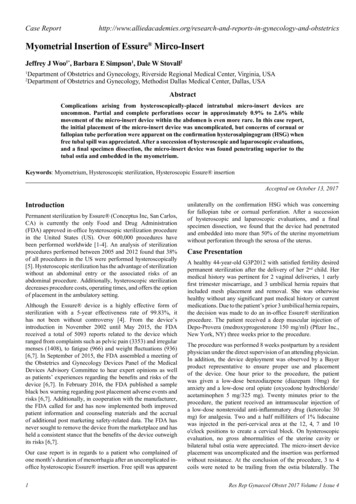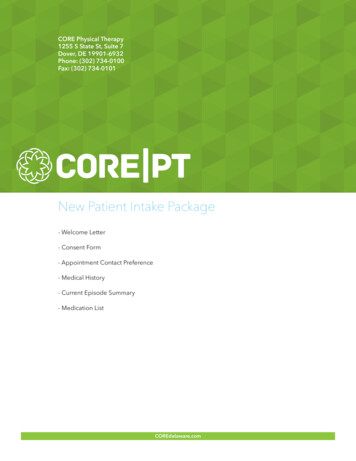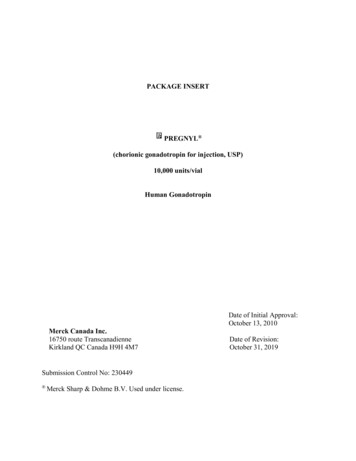
Transcription
PACKAGE INSERTPREGNYL (chorionic gonadotropin for injection, USP)10,000 units/vialHuman GonadotropinMerck Canada Inc.16750 route TranscanadienneKirkland QC Canada H9H 4M7Submission Control No: 230449 Merck Sharp & Dohme B.V. Used under license.Date of Initial Approval:October 13, 2010Date of Revision:October 31, 2019
PACKAGE INSERTPREGNYL (chorionic gonadotropin for injection, USP)10,000 units/vialTHERAPEUTIC CLASSIFICATIONHuman GonadotropinACTIONThe action of human chorionic gonadotropin (hCG) is virtually identical to that of pituitary LH,although hCG appears to have a small degree of FSH activity as well. It stimulates production ofgonadal steroid hormones by stimulating the interstitial cells (Leydig cells) of the testis to produceandrogens and the corpus luteum of the ovary to produce progesterone.Androgen stimulation in the male leads to the development of secondary sex characteristics andmay stimulate testicular descent when no anatomical impediment to descent is present.HCG has no known effect on fat mobilization, appetite or sense of hunger, or body fat distribution.Following IM administration, an increase in serum chorionic gonadotropin concentrations may beobserved within 2 hours. Peak concentrations occur within 6 hours and persist for approximately36 hours. Serum chorionic gonadotropin levels begin to decline at 48 hours reaching undetectablelevels after 72 hours. Chorionic gonadotropin is distributed primarily in the testes and ovaries ofthe male and female respectively, with small amounts possible distributing into the proximaltubules of the renal cortex.Blood levels of chorionic gonadotropin decline in a biphasic manner. The initial phase half-lifehas been reported between 5.6 and 11 hours, whereas the terminal phase half-life has been reported2
between 23 and 37.2 hours. Following IM administration of therapeutic doses, approximately 1012% of the dose is excreted in urine within 24 hours.INDICATIONPregnyl (chorionic gonadotropin for injection, USP) is indicated for:1) Prepubertal cryptorchidism not due to anatomical obstruction. In general, hCG is thought toinduce testicular descent in situations when descent would have occurred at puberty. HCG thusmay help predict whether or not orchiopexy will be needed in the future.2) Selected cases of hypogonadotropic hypogonadism (hypogonadism secondary to a pituitarydeficiency) in males.3) Induction of ovulation and pregnancy in the anovulatory, infertile woman in whom the causeof anovulation is secondary and not due to primary ovarian failure, and who has been appropriatelypretreated with FSH-containing preparations.NOTE: hCG has not been demonstrated to be effective adjunctive therapy in the treatmentof obesity. There is no substantial evidence that it increases weight loss beyond that resultingfrom caloric restriction, that it causes a more attractive or “normal” distribution of fat, orthat it decreases the hunger and discomfort associated with calorie-restricted diets.CONTRAINDICATIONSPregnyl (chorionic gonadotropin for injection, USP) is contraindicated for Prepubertal boys withsigns of anatomical obstruction and for patients with: Precocious puberty3
Hypersensitivity to this drug or to any ingredient in the formulation or component of thecontainer (see WARNINGS AND PRECAUTIONS). Known or suspected sex hormone-dependent tumours, such as ovary, breast and uterinecarcinoma in female and prostatic or breast carcinoma in the male. Malformations of the reproductive organs incompatible with pregnancy. Fibroid tumours of the uterus incompatible with pregnancy. Abnormal (not menstrual) vaginal bleeding without a known/diagnosed cause.WARNINGS AND PRECAUTIONSHCG should be used in conjunction with FSH-containing preparations only by physiciansexperienced with infertility problems who are familiar with the criteria for patient selection,contraindications, warnings and precautions, and adverse reactions described in the packageinsert for FSH-containing preparations.The drug substance of this product is manufactured from human urine. Although the riskis theoretical, and no case of transmission of an infectious agent linked to the use of urinederived gonadotropins has ever been identified, the risk of transmitting infectious agentscannot be completely excluded.Anaphylaxis and other hypersensitivity reactions have been reported with urinary derivedHCG products.4
For males and females:Hypersensitivity reactions: Hypersensitivity reactions, both generalized and local; anaphylaxis; andangioedema have been reported. If a hypersensitivity reaction is suspected,discontinue Pregnyl and assess for other potential causes for the event. (SeeCONTRAINDICATIONS.)General: Patients should be evaluated for uncontrolled non-gonadal endocrinopathies (e.g.thyroid, adrenal or pituitary disorders) and appropriate specific treatment given. Pregnyl should not be used for body weight reduction. HCG has no effect on fatmetabolism, fat distribution or appetite.In the female:Multi-fetal gestation and birth: In pregnancies occurring after induction of ovulation with gonadotropicpreparations, there is an increased risk of multiple pregnancies.Ectopic pregnancy: Infertile women undergoing Assisted Reproductive Technologies (ART) have anincreased incidence of ectopic pregnancy. Early ultrasound confirmation that apregnancy is intrauterine is therefore important.Pregnancy loss: Rates of pregnancy loss in women undergoing assisted reproductive technologies(ART) are higher than in the normal population.5
Congenital Malformations: The incidence of congenital malformations after assisted reproductive technologiesmay be slightly higher than after spontaneous conceptions. This slightly higherincidence is thought to be related to differences in parental characteristics (e.g.,maternal age, sperm characteristics) and to the higher incidence of multiplegestations after assisted reproductive technologies. There are no indications that theuse of gonadotropins during assisted reproductive technologies is associated with anincreased risk of congenital malformations.Ovarian Hyperstimulation Syndrome (OHSS): OHSS is a medical event distinct from uncomplicated ovarian enlargement. Clinicalsigns and symptoms of mild and moderate OHSS are abdominal pain, nausea,diarrhea, mild to moderate enlargement of ovaries and ovarian cysts. Severe OHSSmay be life-threatening. Clinical signs and symptoms of severe OHSS are largeovarian cysts, acute abdominal pain, ascites, pleural effusion, hydrothorax, dyspnea,oliguria, hematological abnormalities and weight gain. In rare instances, venous orarterial thromboembolism may occur in association with OHSS. Transient liverfunction test abnormalities suggestive of hepatic dysfunction with or withoutmorphologic changes on liver biopsy have also been reported in association withOHSS.Adherence to the recommended Pregnyl dose and treatment regimen is advised. Careshould be taken with the administration of Pregnyl because OHSS may be triggered byadministration of human Chorionic Gonadotropin (hCG). OHSS may also be triggered bypregnancy (endogenous hCG). Early OHSS usually occurs within 10 days after hCGadministration and may be associated with an excessive ovarian response to gonadotropin6
stimulation. Late OHSS occurs more than 10 days after hCG administration, as aconsequence of the hormonal changes with pregnancy. Because of the risk of developingOHSS, patients should be monitored for at least two weeks after hCG administration.Women with known risk factors for a high ovarian response may be especially proneto the development of OHSS during or following treatment with Pregnyl. For womenhaving their first cycle of ovarian stimulation, for whom risk factors are only partiallyknown, close observation for early signs and symptoms of OHSS is recommended.Follow current clinical practice for reducing the risk of OHSS during AssistedReproductive Technology (ART). Careful monitoring of ovarian response isimportant to reduce the risk of OHSS. To monitor the risk of OHSS, ultrasonographicassessments of follicular development should be performed prior to treatment and atregular intervals during treatment, the concurrent determination of serum estradiollevels may also be useful. In ART, there is an increased risk of OHSS with 18 or morefollicles of 11 mm or more in diameter.For patients at increased risk of OHSS or if OHSS develops, standard andappropriate management of OHSS should be implemented and followed.Ovarian torsion: Ovarian torsion has been reported after treatment with gonadotropins, includingPregnyl. Ovarian torsion may be related to other conditions, such as OHSS,pregnancy, previous abdominal surgery, past history of ovarian torsion, andprevious or current ovarian cysts. Damage to the ovary due to reduced bloodsupply can be limited by early diagnosis and immediate detorsion.Vascular Complications:7
Thromboembolic events, both in association with and separate from OHSS, have beenreported following treatment with gonadotropins, including Pregnyl. Intravascularthrombosis, which may originate in venous or arterial vessels, can result in reducedblood flow to vital organs or the extremities. Women with generally recognised riskfactors for thrombosis, such as a personal or family history, severe obesity orthrombophilia, may have an increased risk of venous or arterial thromboembolicevents, during or following treatment with gonadotropins. In these women thebenefits of IVF treatment need to be weighed against the risks. It should be noted,however, that pregnancy itself also carries an increased risk of thrombosis.In the male:Antibody formation: Administration of hCG can provoke the formation of antibodies against hCG. In rarecases, this may result in an ineffective treatment.Treatment with hCG leads to increased androgen production. Therefore: Patients with latent or overt cardiac failure, renal dysfunction, hypertension,epilepsy, migraine or asthma (or a history of these conditions) should be kept underclose medical supervision, since aggravation or recurrence may occasionally beinduced as a result of increased androgen production. hCG should be used cautiously in prepubertal boys to avoid premature epiphysealclosure or precocious sexual development. Skeletal maturation should be monitoredregularly.NeurologicAs far as known this medicine has no influence on alertness and concentration.8
Special populationsPregnant women:Pregnyl should not be used after pregnancy is established.Nursing women:Pregnyl must not be used during lactation.ADVERSE REACTIONSAdverse Drug Reaction OverviewHeadache, irritability, restlessness, depression, fatigue, edema, precocious puberty, gynecomastiaas well as pain at the injection site have been reported during treatment with Pregnyl (chorionicgonadotropin for injection, USP). Ovarian cancer has also been reported in a very small numberof infertile women who have been treated with fertility drugs. A causal relationship betweentreatment with fertility drugs and ovarian cancer has not been established.Clinical Trial Adverse Drug ReactionsClinical trials are conducted under very specific conditions and therefore, the adverse drugreaction rates observed in the clinical trials may not reflect the rates observed in practice andshould not be compared to the rates in the clinical trials of another member of the therapeuticclass. Frequencies of adverse drug reactions from clinical trials with Pregnyl is not availablebecause that information was not being collected by the system used in current drug development.Post-Market Adverse Drug Reactions9
General Disorders and Administrative Site ConditionsPregnyl may cause reactions at the site of injection, such as bruising, pain, redness, swelling anditching. Occasionally allergic reactions have been reported, mostly manifesting as pain and/or rashat the injection site. Weight gain has been observed as part of the clinical picture of severe OHSS.Immune System DisordersIn rare cases generalized rash or fever may occur.In the Female:Gastrointestinal DisordersAbdominal pain and gastrointestinal symptoms such as nausea and diarrhea, related to mild OHSS.Ascites, as a complication of severe OHSS.Reproductive and Breast DisordersUnwanted ovarian hyperstimulation, mild or severe OHSS (see WARNINGS ANDPRECAUTIONS).Painful breasts, mild to moderate enlargement of ovaries and ovarian cysts related to mild OHSS.Large ovarian cysts (prone to rupture), usually associated with severe OHSS.Respiratory, Thoracic and Mediastinal DisordersHydrothorax, as a complication of severe OHSS.Vascular DisordersIn rare instances, thromboembolism has been associated with FSH/hCG therapy, usuallyassociated with severe OHSS (see WARNINGS AND PRECAUTIONS).10
In the Male:Metabolism and Nutrition DisordersWater and sodium retention is occasionally seen after administration of high dosages; this isregarded as a result of excessive androgen production.Reproductive System and Breast DisordersHCG treatment may sporadically cause gynecomastia.DRUG INTERACTIONSInteractions of Pregnyl (chorionic gonadotropin for injection, USP) with other medicines havenot been investigated; interactions with commonly used medicinal products can therefore not beexcluded.Following administration, Pregnyl may interfere for up to ten days with the immunologicaldetermination of serum/urinary hCG, leading to a false positive pregnancy test.DOSAGE AND ADMINISTRATIONFOR INTRAMUSCULAR USE ONLY after reconstitution of the dry powder with the sterilediluent. Although the dosage regimen will depend upon the indication, the patient’s age andweight, and the prescriber’s preference, the following regimens have been advocated by variousauthorities.Males:Prepubertal cryptorchidism not due to anatomical obstruction4,000 USP units, 3 times weekly, for 2 to 3 weeks, or 1,000 USP units, 3 times weekly for 6 to 811
weeks. The dosage schedule may vary to some extent, depending upon the age when treatment isgiven. If the dosage is adequate, there will usually be some indication, following one such courseof therapy, whether descent will occur or surgery be required.A therapeutic trial with chorionic gonadotropin may constitute a valuable diagnostic aid todetermine the need for surgery. Lack of response is usually an indication of anatomic obstruction.Furthermore, when surgery is required, the preliminary treatment may facilitate the procedure byincreasing the size of the testes and the length of the cords. Postoperative gonadotropic therapyhas also been suggested to prevent retraction of testes.Age of initiation of treatment: Various ages ranging from early childhood to immediately beforeexpected puberty have been suggested. The average appropriate age, however, appears to be 12years.Selected cases of hypogonadotropic hypogonadism in males4,000 to 5,000 USP units 3 times weekly for 6 to 8 weeks with a rest of period of 2 to 3 weeksbetween courses of therapy.Females:Induction of ovulation and pregnancy in the anovulatory infertile woman in whom the cause ofanovulation is secondary and not due to primary ovarian failure and who has been appropriatelypretreated with FSH-containing preparations (see prescribing information of FSH-containingpreparations for dosage and administration for those drug products).5,000 to 10,000 USP units one day following the last day of treatment with an FSH-containingpreparation (a dosage of 10,000 USP units is recommended in the labeling of FSH-containingpreparations).12
PHARMACEUTICAL INFORMATIONDrug Substance:Chorionic GonadotropinDescriptionChorionic gonadotropin is a glycoprotein substance, with a molecular weight of approximately38600 secreted by the placenta and obtained from the urine of pregnant women. It is composed ofnonidentical and noncovalently linked α and β subunits. The α subunits of CG is essentiallyidentical to the α subunits of the human pituitary gonadotropins, luteinizing hormone and folliclestimulation hormone, as well as to the α subunit of human TSH, however the β subunit of CGdiffers in amino acid sequence from the other hormones.Chorionic gonadotropin occurs as a white or practically white, amorphous powder and is freelysoluble in water.Composition:Each vial of Pregnyl (chorionic gonadotropin for injection, USP) contains: 10,000 USP units ofsterile lyophilized human chorionic gonadotropin plus 5 mg of monobasic sodium phosphatemonohydrate and 4.4 mg of dibasic sodium phosphate anhydrous (pH may have been adjustedwith sodium hydroxide and/or phosphoric acid).Each vial of Pregnyl solvent contains: 10mL of Water for Injection, 0.9% of benzyl alcohol,0.56% sodium chloride and trace amount of sodium hydroxide and/or hydrochloric acid.Stability and Storage Recommendations:Store at 15 C - 30 C.Reconstituted solution is stable for 28 days when refrigerated (2 C - 8 C).13
Incompatibilities:In the absence of compatibility studies, this medicinal product must not be mixed with othermedicinal products.Reconstituted Solution:Direction for reconstitutionReconstitute Pregnyl 10,000 USP units to the desired concentration by addition of the requiredamount of the solvent supplied. Remove 1 to 10 mL of the solvent and add to the vial with thelyophilized Pregnyl , agitate gently until the powder is completely dissolved.When reconstituted with 10mL of the solvent, the concentration of Chorionic Gonadotropin is1,000 USP units/mL. The solvent contains 0.9% benzyl alcohol.14
AVAILABILITYEach package contains two vials: one multi-dose vial of Pregnyl (chorionic gonadotropin forinjection, USP) 10,000 USP units plus one vial of 10 mL sterile Pregnyl solvent.Please note that Pregnyl does not fall under the scope of the “New Drugs” regulation.Therefore, some of the headings in the new Product Monograph format are not applicable.15
PACKAGE INSERT. PREGNYL (chorionic gonadotropin for injection, USP) 10,000 units/vial. Human Gonadotropin . Date of Initial Approval: October
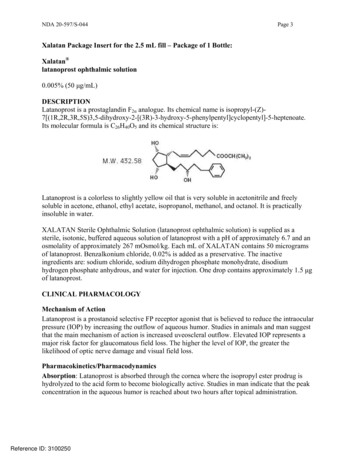


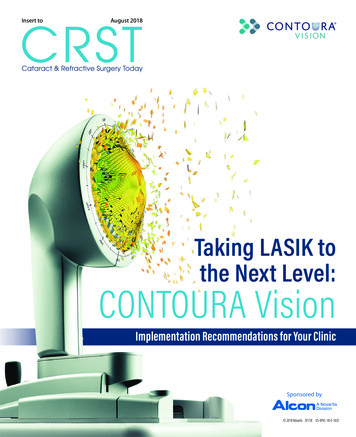

![[Insert Logos] Creating a New National Leader in Adult .](/img/10/ir-deck-for-ndrs-meetings-3-9-17-final.jpg)
